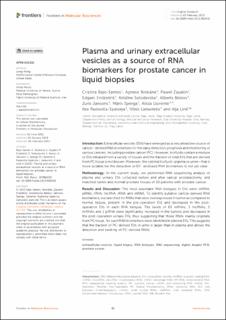Plasma and urinary extracellular vesicles as a source of RNA biomarkers for prostate cancer in liquid biopsies
| dc.contributor.author | Bajo-Santos, Cristina | |
| dc.contributor.author | Brokāne, Agnese | |
| dc.contributor.author | Zayakin, Pawel | |
| dc.contributor.author | Endzeliņš, Edgars | |
| dc.contributor.author | Soboļevska, Kristīne | |
| dc.contributor.author | Belovs, Alberts | |
| dc.contributor.author | Jansons, Juris | |
| dc.contributor.author | Sperga, Māris | |
| dc.contributor.author | Llorente, Alicia | |
| dc.contributor.author | Radoviča-Spalviņa, Ilze | |
| dc.contributor.author | Lietuvietis, Vilnis | |
| dc.contributor.author | Linē, Aija | |
| dc.date.accessioned | 2023-10-19T07:05:06Z | |
| dc.date.available | 2023-10-19T07:05:06Z | |
| dc.date.created | 2023-03-08T12:53:27Z | |
| dc.date.issued | 2023 | |
| dc.identifier.citation | Frontiers in Molecular Biosciences. 2023, 10 1-14. | en_US |
| dc.identifier.issn | 2296-889X | |
| dc.identifier.uri | https://hdl.handle.net/11250/3097410 | |
| dc.description.abstract | Introduction: Extracellular vesicles (EVs) have emerged as a very attractive source of cancer- derived RNA biomarkers for the early detection, prognosis and monitoring of various cancers, including prostate cancer (PC). However, biofluids contain a mixture of EVs released from a variety of tissues and the fraction of total EVs that are derived from PC tissue is not known. Moreover, the optimal biofluid—plasma or urine—that is more suitable for the detection of EV- enclosed RNA biomarkers is not yet clear. Methodology: In the current study, we performed RNA sequencing analysis of plasma and urinary EVs collected before and after radical prostatectomy, and matched tumor and normal prostate tissues of 10 patients with prostate cancer. Results and Discussion: The most abundant RNA biotypes in EVs were miRNA, piRNA, tRNA, lncRNA, rRNA and mRNA. To identify putative cancer-derived RNA biomarkers, we searched for RNAs that were overexpressed in tumor as compared to normal tissues, present in the pre-operation EVs and decreased in the post- operation EVs in each RNA biotype. The levels of 63 mRNAs, 3 lncRNAs, 2 miRNAs and 1 piRNA were significantly increased in the tumors and decreased in the post-operation urinary EVs, thus suggesting that these RNAs mainly originate from PC tissue. No such RNA biomarkers were identified in plasma EVs. This suggests that the fraction of PC-derived EVs in urine is larger than in plasma and allows the detection and tracking of PC-derived RNAs. | en_US |
| dc.language.iso | eng | en_US |
| dc.rights | Navngivelse 4.0 Internasjonal | * |
| dc.rights.uri | http://creativecommons.org/licenses/by/4.0/deed.no | * |
| dc.title | Plasma and urinary extracellular vesicles as a source of RNA biomarkers for prostate cancer in liquid biopsies | en_US |
| dc.type | Peer reviewed | en_US |
| dc.type | Journal article | en_US |
| dc.description.version | publishedVersion | en_US |
| cristin.ispublished | true | |
| cristin.fulltext | original | |
| cristin.qualitycode | 1 | |
| dc.identifier.doi | 10.3389/fmolb.2023.980433 | |
| dc.identifier.cristin | 2132357 | |
| dc.source.journal | Frontiers in Molecular Biosciences | en_US |
| dc.source.volume | 10 | en_US |
| dc.source.pagenumber | 1-14 | en_US |
Tilhørende fil(er)
Denne innførselen finnes i følgende samling(er)
-
Publikasjoner fra Cristin [3269]
-
TKD - Institutt for maskin, elektronikk og kjemi [249]
TKD - Department of Mechanical, Electronics and Chemical Engineering

